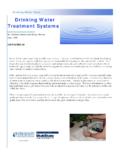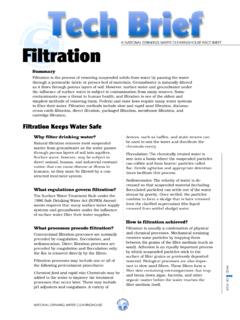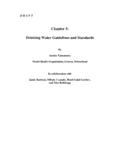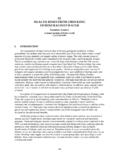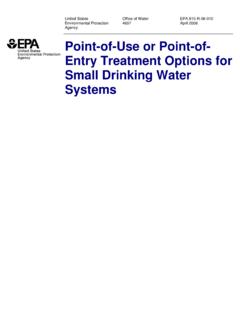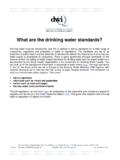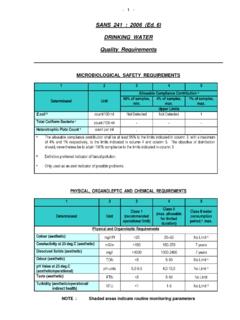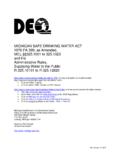Transcription of Understanding the Safe Drinking Water Act - US EPA
1 Understanding the safe Drinking Water Act The safe Drinking Water Act (SDWA) was originally passed by Congress in 1974 to protect public health by regulating the nation s public Drinking Water supply. The law was amended in 1986 and 1996 and requires many actions to protect Drinking Water and its sources rivers, lakes, reservoirs, springs, and ground Water wells. (SDWA does not regulate private wells which serve fewer than 25 individuals.) SDWA authorizes the United States Environmental Protection Agency (US EPA) to set national health-based standards for Drinking Water to protect against both naturally-occurring and man-made contaminants that may be found in Drinking Water . US EPA, states, and Water systems then work together to make sure that these standards are of Americans receive high quality Drinking Water every day from their public Water systems, (which may be publicly or privately owned).
2 Nonetheless, Drinking Water safety cannot be taken for granted. There are a number of threats to Drinking Water : improperly disposed of chemicals; animal wastes; pesticides; human threats; wastes injected underground; and naturally-occurring substances can all contaminate Drinking Water . Likewise, Drinking Water that is not properly treated or disinfected, or which travels through an improperly maintained distribution system, may also pose a health , SDWA focused primarily on treatment as the means of providing safe Drinking Water at the tap. The 1996 amendments greatly enhanced the existing law by recognizing source Water protection, operator training, funding for Water system improvements, and public information as important components of safe Drinking Water . This approach ensures the quality of Drinking Water by protecting it from source to public Water systems must have at least 15 service connections or serve at least 25 people per day for 60 days of the Water standards apply to Water systems differently based on their type and size:Community Water System (there are approximately 54,000) - A public Water system that serves the same people year-round.
3 Most residences including homes, apartments, and condominiums in cities, small towns, and mobile home parks are served by Community Water Water System - A public Water system that serves the public but does not serve the same people year-round. There are two types of non-community systems:Non-Transient Non-Community Water System (there are approximately 20,000) - A noncommunity Water system that serves the same people more than six months per year, but not year-round, for example, a school with its own Water supply is considered a non-transient non-community Water system (there are approximately 89,000) - A non-community Water system that serves the public but not the same individuals for more than six months, for example, a rest area or campground may be considered a transient Water Drinking Water ACT 1974-2004 PROTECT OUR HEALTH FROM SOURCE TO TAPR oles and Responsibilities:SDWA applies to every public Water system in the United States.
4 There are currently more than 170,000 public Water systems providing Water to almost all Americans at some time in their lives. The responsibility for making sure these public Water systems provide safe Drinking Water is divided among US EPA, states, tribes, Water systems, and the public. SDWA provides a framework in which these parties work together to protect this valuable EPA sets national standards for Drinking Water based on sound science to protect against health risks, considering available technology and costs. These National Primary Drinking Water Regulations set enforceable maximum contaminant levels for particular contaminants in Drinking Water or required ways to treat Water to remove contaminants. Each standard also includes requirements for Water systems to test for contaminants in the Water to make sure standards are achieved. In addition to setting these standards, US EPA provides guidance, assistance, and public information about Drinking Water , collects Drinking Water data, and oversees state Drinking Water programs.
5 The most direct oversight of Water systems is conducted by state Drinking Water programs. States can apply to US EPA for primacy, the authority to implement SDWA within their jurisdictions, if they can show that they will adopt standards at least as stringent as US EPA s and make sure Water systems meet these standards. All states and territories, except Wyoming and the District of Columbia, have received primacy. While no Indian tribe has yet applied for and received primacy, four tribes currently receive treatment as a state status, and are eligible for 1996 SDWA Amendment Highlights:C o n s u m e r C o n f i d e n c e Re p o r t s All community Water systems must prepare and distribute annual reports about the Water they provide, including information on detected contaminants, possible health effects, and the Water s Analysis US EPA must conduct a thorough cost-benefit analysis for every new standard to determine whether the benefits of a Drinking Water standard justify the Water State Revolving Fund States can use this fund to help Water systems make infrastructure or management improvements or to help systems assess and protect their source Contaminants and Disinfection Byproducts US EPA is required to strengthen protection for microbial contaminants, including Cryptosporidium, while strengthening control over the byproducts of chemical disinfection.
6 The Stage 1 Disinfectants and Disinfection Byproducts Rule and the Interim Enhanced Surface Water Treatment Rule together address these risks. Operator Certification Water system operators must be certified to ensure that systems are operated safely. US EPA issued guidelines in February 1999 specifying minimum standards for the certification and recertification of the operators of community and non-transient, noncommunity Water systems. These guidelines apply to state Operator Certification Programs. All states are currently implementing EPA-approved operator certification programs. Public Information & Consultation SDWA emphasizes that consumers have a right to know what is in their Drinking Water , where it comes from, how it is treated, and how to help protect it. US EPA distributes public information materials (through its safe Drinking Water Hotline, Safewater web site, and Water Resource Center) and holds public meetings, working with states, tribes, Water systems, and environmental and civic groups, to encourage public Water Systems Small Water systems are given special consideration and resources under SDWA, to make sure they have the managerial, financial, and technical ability to comply with Drinking Water Water Assessment Programs Every state must conduct an assessment of its sources of Drinking Water (rivers, lakes, reservoirs, springs, and ground Water wells)
7 To identify significant potential sources of contamination and to determine how susceptible the sources are to these States, or US EPA acting as a primacy agent, make sure Water systems test for contaminants, review plans for Water system improvements, conduct on-site inspections and sanitary surveys, provide training and technical assistance, and take action against Water systems not meeting ensure that Drinking Water is safe , SDWA sets up multiple barriers against pollution. These barriers include: source Water protection, treatment, distribution system integrity, and public information. Public Water systems are responsible for ensuring that contaminants in tap Water do not exceed the standards. Water systems treat the Water , and must test their Water frequently for specified contaminants and report the results to states. If a Water system is not meeting these standards, it is the Water supplier s responsibility to notify its customers.
8 Many Water suppliers now are also required to prepare annual reports for their customers. The public is responsible for helping local Water suppliers to set priorities, make decisions on funding and system improvements, and establish programs to protect Drinking Water sources. Water systems across the nation rely on citizen advisory committees, rate boards, volunteers, and civic leaders to actively protect this resource in every community in & Prevention:Essential components of safe Drinking Water include protection and prevention. States and Water suppliers must conduct assessments of Water sources to see where they may be vulnerable to contamination. Water systems may also voluntarily adopt programs to protect their watershed or wellhead, and states can use legal authorities from other laws to prevent pollution. SDWA mandates that states have programs to certify Water system operators and make sure that new Water systems have the technical, financial, and managerial capacity to provide safe Drinking Water .
9 SDWA also sets a framework for the Underground Injection Control (UIC) program to control the injection of wastes into ground Water . US EPA and states implement the UIC program, which sets standards for safe waste injection practices and bans certain types of injection altogether. All of these programs help prevent the contamination of Drinking National Drinking Water Standards:US EPA sets national standards for tap Water which help ensure consistent quality in our nation s Water supply. US EPA prioritizes contaminants for potential regulation based on risk and how often they occur in Water supplies. (To aid in this effort, certain Water systems monitor for the presence of contaminants for which no national standards currently exist and collect information on their occurrence). US EPA sets a health goal based on risk (including risks to the most sensitive people, , infants, children, pregnant women, the elderly, and the immuno-compromised).
10 US EPA then sets a legal limit for the contaminant in Drinking Water or a required treatment technique this limit or treatment technique is set to be as close to the health goal as US EPA sets primary Drinking Water standards through a three-step process:F i r s t , U S E PA i d e n t i f i e s c o n t a m i n a n t s t h a t m a y a d v e r s e l y a f f e c t p u b l i c h e a l t h a n d o c c u r i n d r i n k i n g w a t e r w i t h a f r e q u e n c y a n d a t l e v e l s t h a t p o s e a t h r e a t t o p u b l i c h e a l t h . U S E PA i d e n t i f i e s t h e s e c o n t a m i n a n t s f o r f u r t h e r s t u d y, a n d d e t e r m i n e s c o n t a m i n a n t s t o p o t e n t i a l l y r e g u l a t e . S e c o n d , U S E PA d e t e r m i n e s a m a x i m u m c o n t a m i n a n t l e v e l g o a l f o r c o n t a m i n a n t s i t d e c i d e s t o r e g u l a t e.










